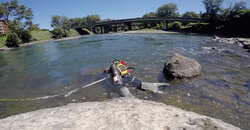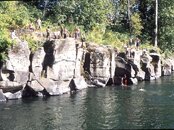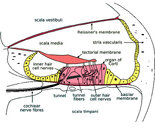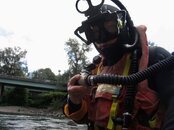I just watched this presentation on Facebook, and really appreciate it. I'm a 76 year old diver, who's been diving consistently since 1959. I still dive, and do so mostly solo at a park, High Rocks on the Clackamas River. As such, I must do some exertion, both getting to the site by walking in full gear in and out, and in the river as there are fairly high current situations. I'm no where near my prime in my 20s, but I'm sufficiently in good shape physically to be able to carry off these dives without problems. I'm interested in underwater photography/videography, and have captured some interesting videos. I'm also interested in the science of underwater swimming, and have developed some swimming techniques that, even at my age, allow me to swim quite fast. I sometimes swim against the current.
There are two things in the video that I would like to talk about, vision for older divers and hearing loss.
Concerning vision
Concerning vision, I'm talking only about being far-sighted, and the difficulty that presents to older divers. In the presentation, the recommendation was either contact lenses, or a prescription mask. I have tried the prescription mask solution, and found that it caused me some problems exiting on the slippery rocks on the river bank. So I stopped using the prescription (it interferred with down vision upon exit). My wife is from Hong Kong, and I met a fellow there who was an optomitrist before retiring, and also head of the department of optometry at a Hong Kong university. He had invented, and manufactured, a product he calls the SeawiscopeEY, which attaches to a mask and can be flipped up, out of the way. I now use this product in most of my dives where I want to observe aquatic life underwater. Here's on entry from my dive log from a dive in 2011:
Date: 6-18-2011 Dive Site: High Rocks, Clackamas River
I went to the bottom, and was swimming upstream toward the shallower areas of the eddie. The bottom here is rocky with gravel on the bottom. As I started up, I noticed a brown Pacific lamprey. It was going my direction, so I decided to stop for a moment and watch it. The lamprey (Lampetra tridentate) was brown rather than grey, indicating to me that it had not been in the river too long.
I swam up the gravel bank from about 15 feet depth to about 10 feet depth, nearing the bottom portion of this eddy but where there was still a downstream current. There I saw two more lampreys, which were joined by this third one, on the bottom holding onto stones in their mouths. Then they curled around each other, and began mating. I reached up to my mask and brought the SeawiscopeEY down in position on my mask. This is a double-lens device that allows very close focusing and observations. With it down, and the two lampreys in a mating position (one male attached itself to the female’s head, and circled her body with his), I watched in amazement as they convulsed in a mating orgasm, and eggs and sperm came out. After a moment, the male released his grip on her head, and the three lampreys began moving stones over the site. At first. It was small stones being moved out, then large stones were moved on top. They kept moving the stones in the river, and the large ones were bigger than my fist. One lamprey would cling to the stone with his/her mouth, then with body undulations try to displace it from the bottom. The larger stones were moved over the area of the eggs, which were sticking to the rocks on the bottom. Some had drifted back in the current too.
This process was repeated at least five times while I watched during the next 20 minutes. The male would grab the head of the female, wrap his body around the female and they would release sperm and eggs in what could only be described as a body convulsion, a fast-frequency twitching of the whole lower bodies of the two fish. This would be followed by several minutes of moving stones on the bottom. This was a cooperative effort by three lampreys. At one point, the dominant male tried mating with the female, and because the other male was along-side could only wrap his body around the both of them. That did not work, so he would change his body position slightly and try again. Finally, and only after he had successfully wrapped his body only around her, the mating commenced again.
Special Problems and their Proposed Solutions:
1. I was really glad I had dived today. I almost did not, as the conditions were what I considered marginal for diving (weather, visibility, current).
2. The SeawiscopeEY enabled me to get within a foot of the lampreys as they were mating and watch it very, very closely. It was absolutely amazing to see. Using a quiet double hose regulator helped this too; I don’t think I could have made these observations at this distance with a single hose regulator.
The SeawiscopeEY ("EY" for "Ever Young") is available at the following website:
SeawiscopeEY is a near vision aid for divers who have difficulties to read dive computers, check out, examine small creatures and frame them within underwater LCD camera monitor. It is not a gauge reader, but much more and better.
scuba-vision.com
Concerning Hearing Loss
I am on the
Noise Committee for the American Industrial Hygiene Association (AIHA). Indeed, as was presented, it is noise and not pressure, or ear problems, which leads to most hearing loss. Hearing loss can occur if there is a ruptured ear drum, or other problems with the inner ear (leading also to balance problems), but normally this does not occur. However, we in our modern society experience noise almost constantly. I carry around foam ear plugs that I can use in the darnedest places (concerts, near highway traffic, boat noises, on airplanes, in industrial settings, etc.). It is noise that accumulates over a lfietime which damages hearing. It does so by damaging the tine hair cells inside the colclea, in the inner ear. Once these hair cells are damaged, they don't regenerate. They are gone, so we need to protect our hearing constantly, throughout life.
So how does a diver get exposed to noise? Well, in boats, travel to the dive site, cylinder air hissing out of a cylinder, and air compressors are just a beginning to our exposure to noise.
Below are some photos from my dive site at High Rocks, and of the cochlea. I also included a photo of me preparing for a dive with my SeawiscopeEY.
SeaRat








